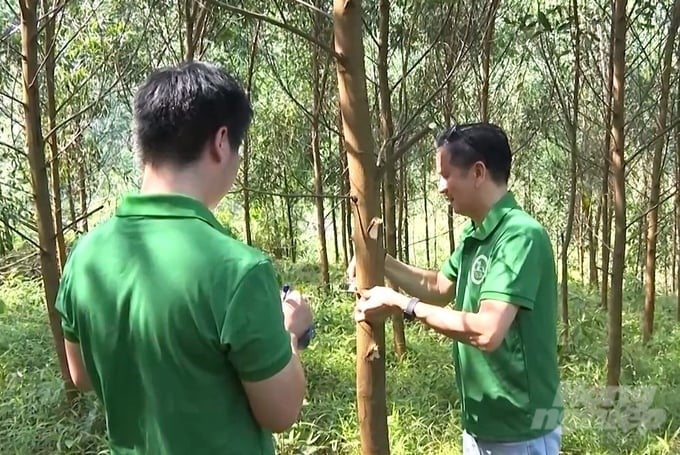November 20, 2025 | 13:09 GMT +7
November 20, 2025 | 13:09 GMT +7
Hotline: 0913.378.918
November 20, 2025 | 13:09 GMT +7
Hotline: 0913.378.918

The model of intensive large timber forest planting in the direction of sustainable forest management for processing and export was implemented by the National Agricultural Extension Center and the Vietnam National University of Forestry on a scale of 25 hectares. Photo: Dao Thanh.
The model of intensive large timber forest planting in the direction of sustainable forest management for processing and export was implemented by the National Agricultural Extension Center and the Vietnam National University of Forestry in 2022 on a scale of 25 hectares. Up to now, the model has had 11 participating households in 2 communes: Trung Son and Dao Vien of Yen Son district, Tuyen Quang province. Participating households are provided with seedlings and fertilizer in accordance with the approved estimate in terms of quantity and quality.
During the planting and care process, due to being planted on land that had experienced many acacia plantings, some trees were infected with the wilt disease caused by the fungus Ceratocystis manginecans. However, the project guided people on measures to cut down dead trees and spray Trichodema fungus medicine combined with Ridomil Gold in a timely manner so the disease did not spread.
Mrs. Dinh Thi Nhi's family, Trung Son commune, Yen Son district, participates in the model with an area of 3.2 hectares. She received more than 5,800 seedlings and over 1,000 kg of NPK fertilizer. Mrs. Nhi said that the model's acacia variety is a tissue hybrid acacia variety that has been recognized by the Ministry of Agriculture and Rural Development, with the lines AH1, AH7, and BV16. After nearly 2 years of planting, as of now, the acacia garden of Mrs. Nhi's family has developed quite well. The average root diameter reaches 6-7 cm, and the average height reaches 6-7 cm.
According to Mrs. Nhi, when participating in the model, households like her gained more knowledge about planting and caring for acacia trees associated with environmental protection and not using herbicides so that the forest could develop sustainably and meet the standards of exporting to Europe.
If the model of intensive large timber forest planting in the direction of sustainable forest management is replicated, it will be the basis for the people in Tuyen Quang province to well exploit the natural and socio-economic conditions, create highly competitive forest products in the domestic market, and export them to the international market.

After nearly 2 years of planting, as of now, the households' acacia gardens have developed quite well, with an average root diameter of 6-7 cm and an average height of 6-7 cm. Photo: Dao Thanh.
Households participating in the model are trained in techniques for handling vegetation, digging holes, planting, and caring for trees to ensure good growth and development.
A team of officials and experts closely monitors site conditions suitable for hybrid acacia species and instructs people to clear vegetation and limit local burning to try to retain as much organic matter as possible.
Assoc. Prof. Dr. Nguyen Minh Thanh, senior lecturer at the Vietnam National University of Forestry, said that during the process of implementing the model, the project manager, local government, and people regularly coordinated to conduct discussion meetings on the purposes and responsibilities of participating parties; coach on technology transfer; urge and guide households to carry out planned activities (treating vegetation, digging holes, basal fertilizing, planting, caring for, etc.). Compared to the mass planting model, this model's trees grow and develop 1.2–1.5 times faster.
The Vietnam National University of Forestry also established a project implementation team to support the project manager in fully implementing items from contractor selection, bidding, contract signing, and checking the quality of seedlings and fertilizers according to the quantity and quality of the approved project. At the same time, organize annual field and record inspections according to regulations.
The model of intensive large timber forest planting with tissue acacia trees in Tuyen Quang province not only brings high economic efficiency to households but also contributes greatly to environmental efficiency. Planting at a reasonable density and taking care with proper techniques will limit erosion and protect water sources.
From the positive results of the 25 hectares deployed in 2022, the National Agricultural Extension Center, the Vietnam National University of Forestry, and the Tuyen Quang Department of Agriculture and Rural Development continue to select the locations and households to implement the project on a scale of 15 hectares in 2024. As of now, the units have selected six qualified households in Trung Son and Dao Vien communes, Yen Son district, Tuyen Quang province to deploy the model, which is expected to take place in July 2024.
Translated by Thu Huyen

(VAN) This is the study conducted by IRRI and Can Tho University on the rice straw value chain in Mekong Delta showing an economic potential of more than 6.6 trillion VND/year.

(VAN) By participating in cooperative economics, many farmers in Tay Ninh have overcome hardship, mastered clean dragon fruit cultivation techniques.

(VAN) The crossbreeding program in the former Binh Dinh province (now part of Gia Lai) has shown signs of decline, and urgent measures are needed to revive it and sustain past achievements.

(VAN) The agricultural sector agreed on a roadmap to pilot the MRV protocol and expand low-emission rice production from the 2025-2026 winter-spring crop.

(VAN) Agricultural extension officers in Quang Ninh do more than transmit knowledge; they have become a steadfast support system for farmers on the path to sustainable agricultural development.

(VAN) The development of a high-quality beef cattle herd has brought major benefits to livestock farmers, creating jobs and enabling better use of agricultural by-products.

(VAN) In the eastern region of Gia Lai, crossbred cattle now account for 93%, forming a high-quality beef herd and establishing a recognized brand, the result of 35 years of persistent effort.